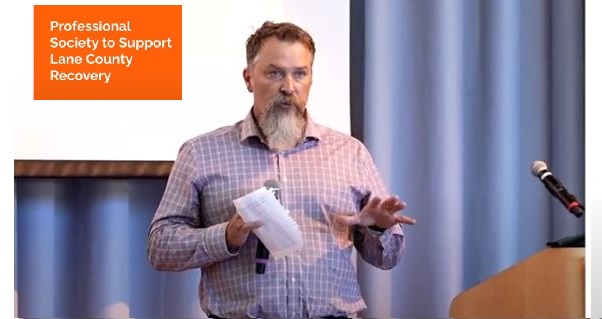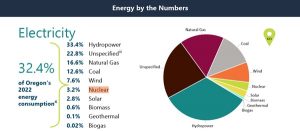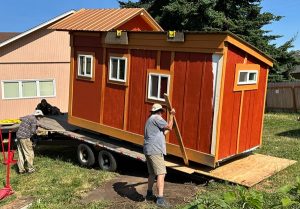McKenzie experience inspires support for long-term disaster recovery
6 min read
Even as they continue their own long recovery from the Holiday Farm Fire, McKenzie Valley residents are helping other communities. Lane County Recovery Manager Matt McRae:
Matt McRae (Lane County, recovery manager): I have been working with Jennifer Gray Thompson and a couple other folks on the concept of developing a professional association for people who are working in disaster recovery. Because she has done so much work in that field, it was obvious to work with her in thinking about what that might look like.
[00:00:30] And so when she was putting together the program for the 2024 Summit, she invited us to take a few minutes to talk with the group that was there about that concept.
[00:00:40] Presenter: Speaking in September at the wildfire leadership summit in Sonoma, Matt McRae.
[00:00:45] Matt McRae (Lane County, recovery manager): I work in Lane County, which is Oregon, north of here about eight hours by car. Lane County contains the town of Eugene, and I’m working to support wildfire recovery up the McKenzie River. I’ve been doing that job for about three and a half years now.
[00:00:58] And so, I was in this position working on recovery as the recovery manager for Lane County, and I started to reach out for examples to try and see what have other people done, and again, After The Fire being a tremendous resource as a point of contact.
[00:01:13] But when we start needing other templates of like assessments, housing assessments, behavioral health assessments, there’s a whole host of things that as a recovery manager, a person steps into and certainly these things haven’t been done before.
[00:01:29] But there was no centralized place where all those, where there were good examples that lived. I could spend a bunch of time on the internet scouring and finding some examples, but I didn’t know whether they were good examples or really bad examples. And in the middle of recovery at the end of year one, the last thing you want to do is be scouring the internet because there’s so much stuff to do, so much work to be done.
[00:01:50] Working in a small county government trying to figure out how to do this job—I had never done recovery before—and certainly we have examples from Florida and Texas, right, who can inform this work, but we’re not as methodical about it as we could be. And I feel like, as somebody who has wandered through that space before, there’s a lot of opportunity for us to get better at supporting each other so that we can all do this job better.
[00:02:16] So it was really that space that drove me into a conversation with Jennifer (Gray Thompson) and Michael (McCormick) about: Can we fill that space? What can we do so that we can better support each other?
[00:02:27] Presenter: A professional association dedicated to community recovery would have been helpful. In a telephone interview Dec. 30, Matt McRae:
[00:02:36] Matt McRae (Lane County, recovery manager): When I think about it, there’s a whole host of things that any professional association can provide.
[00:02:42] Certainly mentoring for somebody who’s never been through a disaster recovery before, seems like there’s a need for that, and an obvious service that a professional association could provide.
[00:02:53] As somebody working at the local government level in disaster recovery, myself, there aren’t readily available resources to see other examples or templates of the kind of products that a person would use regularly in disaster recovery.
[00:03:10] So, for example, looking at a housing assessment of what kind of housing is needed, and the different scales and types of housing that might be needed.
[00:03:19] Or, for example, a behavioral health assessment is something that might be conducted post-disaster to understand what the needs are and what the solutions might look like to support behavioral health and wellness in a disaster-affected community.
[00:03:34] So my observation is that a lot of us working in local government disaster recovery are making things up from scratch or borrowing from neighbors that we might know who have been through this before, but there’s not a formalized method for us all to share the best practices and what we’re working on.
[00:03:55] From my perspective, that would be super valuable—is just seeing the best practices from across the country and long-term disaster recovery in one place—where I can go and find materials that have been vetted and screened, so we’re using the best examples available, and continuing to improve on those as a cohort of professionals working in this arena. And that just doesn’t exist yet.
[00:04:17] My conversations with people who are working at local government levels on disaster recovery is that there is absolutely a need for a professional association to support this work. I hear that whenever I’m talking with my peers. So I think there’s an opportunity there for us to get better at doing this work.
[00:04:38] Presenter: Other emergency personnel have their own professional organizations. And in his experience, the long-term recovery phase is very different from the response phase. At Sonoma in September, Matt McRae:
[00:04:50] Matt McRae (Lane County, recovery manager): I just want to call out, there are definitely resources—there are peer network resources for emergency managers. They’re very robust. There’s a tremendous resource for first responders to share best practices and get good at what they’re doing. That doesn’t exist on the recovery front.
[00:05:06] FEMA, as many of you may know, has written a book on recovery. But as many of you also know, they’re typically gone by about Month 18, right? Is this your experience as well? By Month 18, the last person from FEMA had left our stage, and so you know, their recovery plan, I think, is based on short-term recovery, not the long-term recovery that we’re talking about today.
[00:05:28] And from my perspective, long-term recovery is a lot more like development—like community development on steroids than it is emergency management.
[00:05:37] Presenter: As the focus of recovery shifted to housing, that also meant changes at the county’s Land Management Division. In a telephone interview Dec. 30, Matt McRae:
[00:05:47] Matt McRae (Lane County, recovery manager): So Oregon Department of Emergency Management was very involved early on in recovery, but then handed the baton over to Oregon Housing and Community Services, which is really managing the federal funds from Housing and Urban Development.
[00:06:03] One of the investments that was made early on was hiring a permit navigator, which is a person in our permit office who is focused specifically on serving customers and residents in the disaster affected area.
[00:06:17] So that person has specialized knowledge about the unique policies or incentives that are available to folks who are affected by disaster. It also provides a level of consistency in terms of disaster survivors being able to reach the same person over and over again so that they’re able to have, like, one continuous conversation.
[00:06:38] Presenter: Matt shared a few other important points.
[00:06:40] Matt McRae (Lane County, recovery manager): Big picture, as with anything in emergency management, the emergency response and recovery are better when the relationships between parties working on response and recovery know each other before the disaster. So, as always, there’s a lot of importance placed on knowing our community partners, because they’re the ones that are involved on the ground and that we’re going to be working with from the get-go.
[00:07:07] I think the biggest thing to share is that disaster recovery is a really long process. It’s been over four years since the Holiday Farm Fire, but the recovery is not complete. That’s easy to see for folks who have driven up the McKenzie, but for those who haven’t yet, one can see that there’s still a lot of work to do. It’s a 10-year effort, you know, at least. So yeah, there’s, there’s a lot of work left to do and a lot of people on the ground working to do it right now. And so I think it’s just important for the community and for those of us that live in this area to continue to support recovery efforts because it’s not done yet.
[00:07:48] Presenter: Lessons learned from the McKenzie long-term recovery may benefit others in the future, as Matt McRae and others consider a professional organization focused on disaster recovery. Matt and Lane County Commissioner Heather Buch presented at a wildfire summit in September 2024. You can see the full conference at their You Tube channel.






